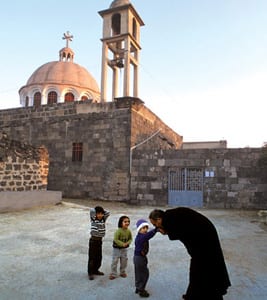Scattered throughout the Middle East — and increasingly, the Americas, Europe and Oceania — a Christian community continues to bear a nickname first coined by its adversaries more than 1,500 years ago.
A Melkite (from the Syriac, malkaya, meaning “of the king”) once referred to a Christian who supported an emperor ruling from the city of Constantinople, now modern Istanbul; spoke Greek; lived in an urban center in the eastern Mediterranean region; and accepted the decrees of the Council of Chalcedon, promulgated in the year 451.
Today, most Melkites are Arabic-speaking Christians, or descendants of Arab-speakers, who belong to a church steeped in the traditions of the Christian East yet accept full communion with the pope in Rome. They are increasingly on the move, displaced from their livelihoods in a volatile Middle East, settling in the West, especially South America, where now more than half of all Melkites live. Though Melkite Greek Catholics constitute a small church within the Catholic communion, they boldly assert their rights, privileges, prerogatives and traditions while actively seeking unity with their Orthodox kin, from whom they have been separated since the early 18th century.

Eventually, the church of Antioch sided with Constantinople. When the Crusaders seized Antioch in 1098, they appointed a Latin patriarch and expelled the Melkite incumbent, who fled to Constantinople. It was during this period of exile that the original liturgical rites utilized by the Melkites and identified as “Antiochene” were replaced by the Byzantine rites of the church of Constantinople.
Based in the war-weary Syrian capital of Damascus, the worldwide Melkite Greek Catholic Church is led by the vigorous Patriarch Gregory III and a synod of bishops not fearful of tackling challenging issues. “Christianity survived in the Middle East because of the married priests,” said one, Archbishop George Bakhouny of Akka in Israel. The Eastern tradition, he said, is “to choose someone who has his own work in the particular village, a good man, a faithful man, a Christian man. He will study a little bit, some theology and philosophy, and he will be ordained.” It doesn’t matter, he continued, if it is impractical to send a married man to the seminary for six years.
“We don’t want all of them to be doctors or theologians,” he said, but witnesses. Priests don’t all have to be well-spoken orators; they could even be fishermen.
Read a full account of the Melkite Greek Catholic Church from ONE magazine here.